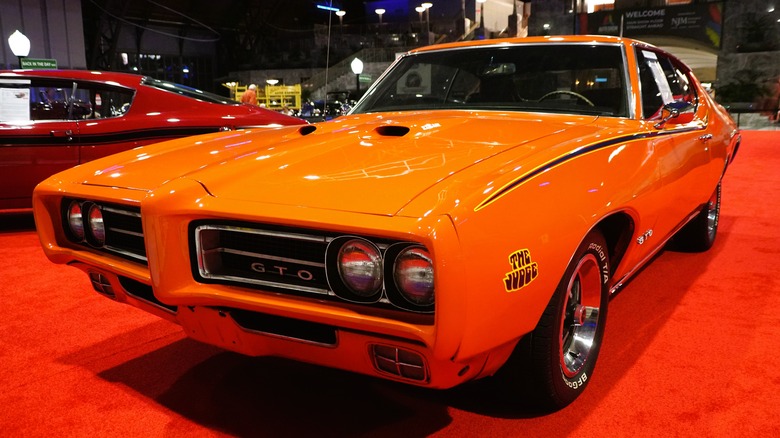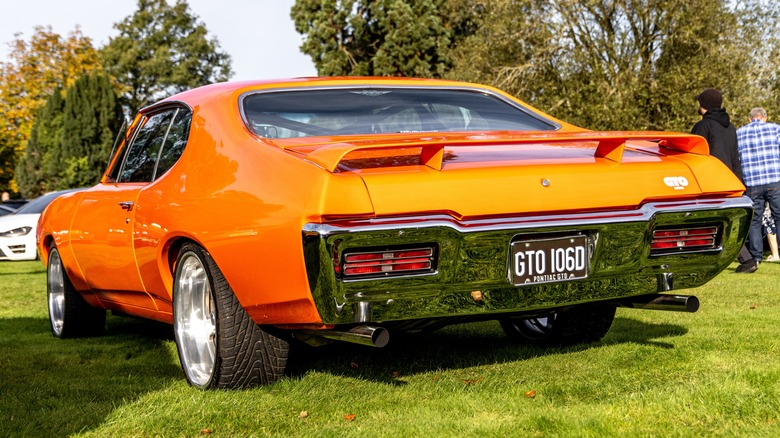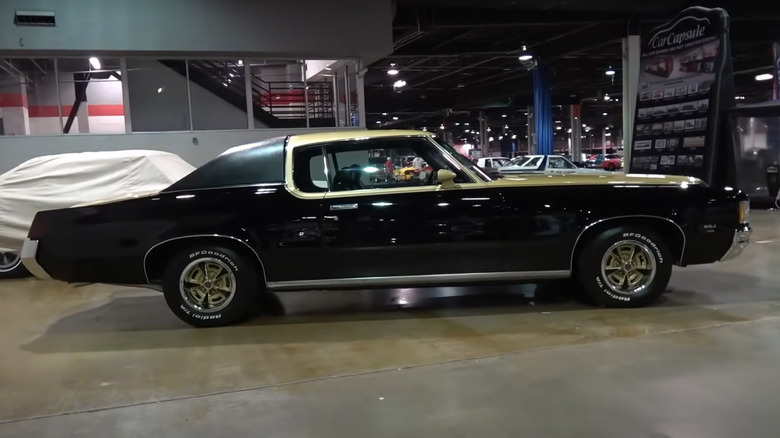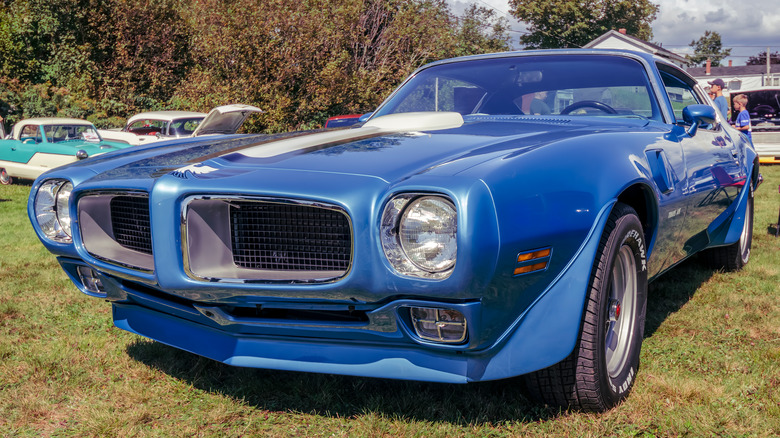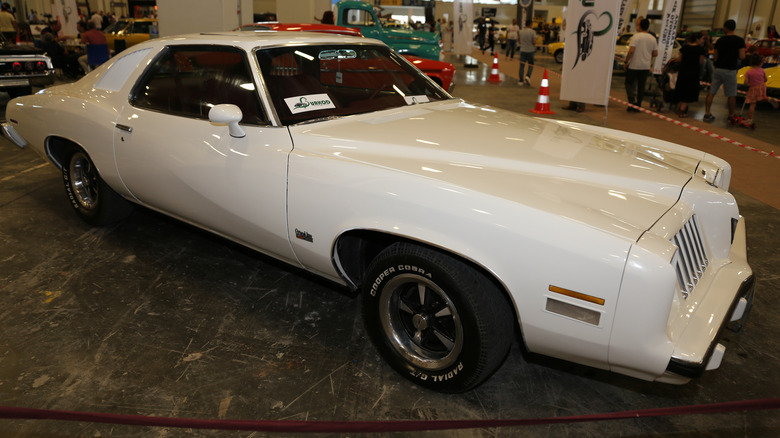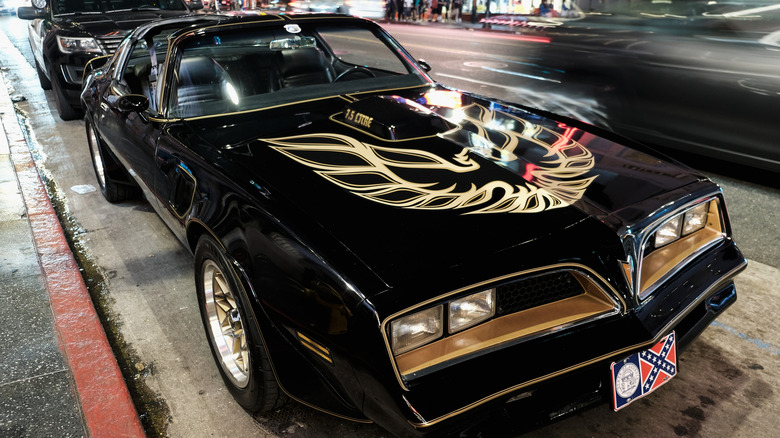5 Legendary Pontiac Models From The 1970s (And How Much They're Worth Today)
The 1970s were both the best of times and the worst of times for Pontiac and the performance car world in general. The early 1970s were peak years for the high-performance cars that had been coming out of Detroit since the mid-1960s, when Pontiac, led by John Z. DeLorean, had transformed itself into a performance icon. Unfortunately, steadily tightening emissions standards, ridiculously high insurance premiums, and a problematic economy would eventually take their toll on these high-powered masters of the highways, the back roads, and the drag strips. By the end of the 1970s, the thundering monsters that lived rent-free in enthusiasts' imaginations would be shadows of their former selves.
But despite these gathering storm clouds, Pontiac continued to crank out cars throughout the decade that captivated 1970s buyers and 21st century collectors alike. Here are five legendary Pontiac models from the 1970s and how much money you'll see them go for today. These awesome Pontiacs are listed in chronological order by model year.
1970-71 Pontiac GTO Judge
The Pontiac GTO Judge first appeared as a 1969 model and had its life extended through the 1970 and 1971 model years. Intended as a way to improve GTO sales by adding a high-performance model at a premium price, The Judge package, named for the TV skit "Here Comes The Judge" that became very popular on the weekly 1960s show "Rowan and Martin's Laugh-In," was a $332 option.
It included a unique orange exterior color that was actually named Carousel Red (other colors were added later), "The Judge" decals and matching stripes, a Hurst shifter with the three-speed manual transmission, the iconic rear spoiler, and Pontiac's 400 cubic inch, 366-horsepower Ram Air III engine. The 370-horsepower Ram Air IV was optional, as were a four-speed manual, a three-speed automatic, power steering, front disc brakes, hood-mounted tach, and limited-slip diff.
While the Judge helped to boost GTO sales, it did not help enough. Sales in 1969 were 20% below those of 1968 at just over 72,000 units, including 6,725 Judge coupes and just 108 convertibles. Judge production consisted of 3,797 cars built in 1970 and a mere 374 in 1971, with production of the model ending in February 1971.
Auction prices of the 1970-71 Pontiac GTO Judge over the past year have ranged from $55,000 to $101,200, with one of the rare convertibles going for $177,500 at Mecum. The highest recorded price is $1,100,000 for a 1970 Judge convertible with the Ram Air IV engine and automatic transmission, also at Mecum.
1970-72 Pontiac Grand Prix SSJ
The 1970-72 Pontiac Grand Prix SSJ was Hurst's unique take on Pontiac's Grand Prix personal luxury coupe. Hurst, known for its very popular aftermarket shifters, had an association with Oldsmobile, producing the successful 455 V8-powered Hurst/Olds 4-4-2 cars starting in 1968.
The Grand Prix SSJ project began when Jim Wangers, Pontiac's ad-agency performance-marketing genius, showed his customized white Grand Prix with gold accents to George Hurst, the company's head. Hurst bought the car from Wangers to develop what would become the SSJ.
Ordering an SSJ required each customer to order a Grand Prix in a very specific way. The dealer then completed a Hurst order form for the SSJ conversion. The car was built by Pontiac and shipped to Hurst, where the conversion was done, after which it was shipped to the dealer for delivery to the customer. The conversion consisted of metallic gold accents, hand-painted pinstripes, electric sunroof, landau half-top, gold wheels, and SSJ emblems. Innovative Hurst-installed options included a TV, telephone, and performance computer.
While the SSJ was essentially a cosmetic package, the Grand Prix had a standard 400 cubic-inch V8 engine, with a 455 as an option. Hurst offered performance upgrades that included engine blueprinting and their Auto/Stick shifter.
Most SSJs were white, with some in black, plus a few in other colors. Records are sketchy, with an estimated 272 1970s, 157 1971s, and 60 1972s made.
Due to its rarity, only one unmodified SSJ has come to auction in recent years. It sold for $56,000 on Bring a Trailer in 2021.
1970 1/2-73 Pontiac Firebird Trans Am
The 1970 1/2-1973 Pontiac Firebird Trans Am was the initial incarnation of the second generation of Pontiac's pony car. As opposed to the first generation Firebird's rushed development, the second generation Trans Am was painstakingly engineered to be a top-tier road car, well-suited to both thrilling straight-line acceleration and confident handling in the twisties. Its appealing styling was a combination of Pontiac split-grill, Endura-bumpered DNA and a sloping roofline inspired by the Ferrari 250GT SWB Coupe.
The Trans Am model cost $1,430 on top of the basic Firebird's $2,875 sticker. For a total of $4,305, you got a 400 cubic-inch, 345 horsepower Ram Air III engine mated to a four-speed manual transmission, a functional shaker hood scoop, variable-ratio power steering, suspension with special shocks and springs, ventilated disc brakes, limited-slip differential, Firestone Wide Oval F60-15 tires, front and rear spoilers, and air extractors on the fenders. Inside was an engine-turned dash panel and a Hurst shifter on the four-speed manual. All of this was standard equipment. You could initially have any color as long as it was Lucerne Blue with white stripes or Polar White with blue stripes.
1970 1/2-1973 Pontiac Firebird Trans Am auction prices during the last 12 months have landed between $48,300 and $260,000 for unmodified examples. The highest price paid of $260,000 was at Mecum for a 1973 Trans Am equipped with the rare (only 252 in 1973), hand-built, 455-cubic-inch Super Duty engine.
1973-75 Pontiac Grand Am
The 1973-75 Pontiac Grand Am was promoted by Pontiac as "a cross between a Grand Prix and a Trans Am." As upscale European sport sedans like BMW and Mercedes-Benz were taking increasing bites out of the market, Pontiac created a new vehicle with some European flavor. Built on the A-body rear-wheel drive platform that was shared with its Chevy, Buick, Olds, and other Pontiac siblings, the Grand Am offered two-door and four-door body styles.
The standard engine was a 400 cubic inch V8, with a 455 V8 optional. Other standard equipment included 7" wide wheels with radial tires (radials were new to Americans but used by Europeans), a Radial Tuned Suspension (called RTS), variable-ratio power steering, sway bars front and rear, bucket seats, and fully instrumented dash with genuine mahogany veneer. The Grand Am's body featured a body-colored Endura front bumper that met the new Federal 5-mph standard, B-pillar louvers, and gracefully sloping rear deck.
The Grand Am was well-reviewed, but it failed in the market for several reasons. The Grand Prix was more of a luxury car for slightly more money. The 1973 fuel embargo hit, and the Grand Am offered only large, thirsty engines. And it was expensive. A total of just 43,146 Grand Ams were produced in 1973, dropping to 17,083 in 1974 and 10,679 in 1975, its final year.
There have been only two 1973-75 Pontiac Grand Ams sold at auction in the past year, both 1973s. One went for $43,500 and the other reached $56,073, both on Bring a Trailer.
1977-78 Pontiac Firebird Trans Am from Smokey and the Bandit
Our final Pontiac could be the most legendary, thanks to its starring role in the blockbuster Burt Reynolds movie "Smokey and the Bandit." Even though the black-and-gold LE trim package was made for many years afterward, the 1977 and 1978 Pontiac Firebird Trans Ams are the only two model years with the exact look of the Bandit's car.
Fun fact: Due to the timing of the production, the filmmakers used 1976 Trans Ams that were updated with 1977 parts. Pontiac would then have the right car to sell when the customers came flooding in after the movie's May 27, 1977, release. And flood in they did — Trans Am sales went from 46,701 in 1976 to 68,745 in 1977, 93,341 in 1978, and 117,108 in 1979. Mission accomplished, Pontiac!
While these Trans Ams looked the part, their power was down to typical late 1970s levels. In 1977, the standard 400 cubic-inch V8 put out only 180 horsepower, while California cars got a compliant engine with 185 horses. Optional on 49-state cars was a same-sized 200-horsepower V8, boosted to 220 hp in 1978 with the W72 upgrade.
Auction prices for these most of these 1977-78 black-and-gold Trans Ams over the past year go from a low of $22,000 to a high of $137,500, both at Mecum. There was one exceptional sale of $242,000 for a 1977 Trans Am that was personally owned by Burt Reynolds, even though another of his Pontiac Firebirds sold for much more.
